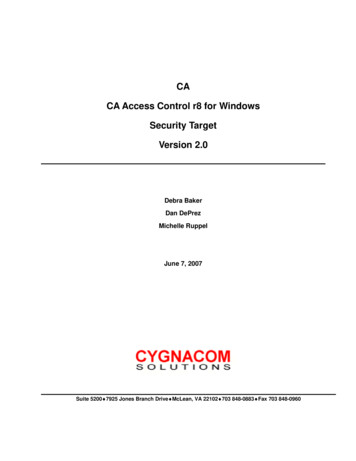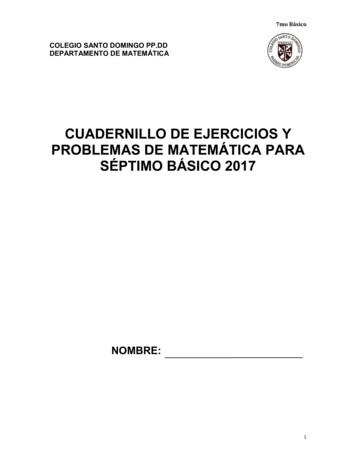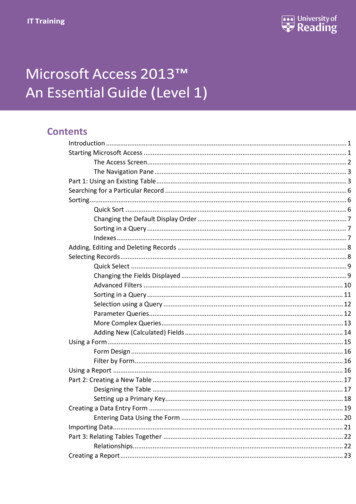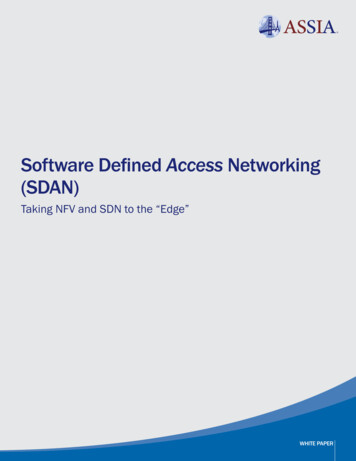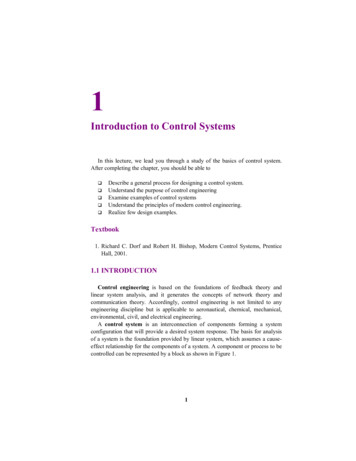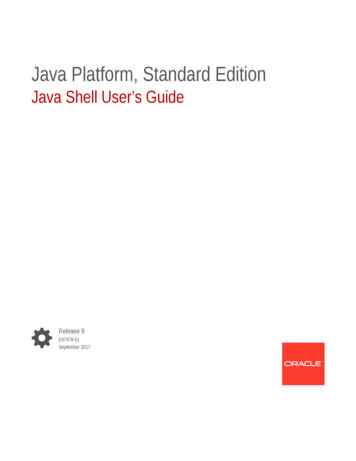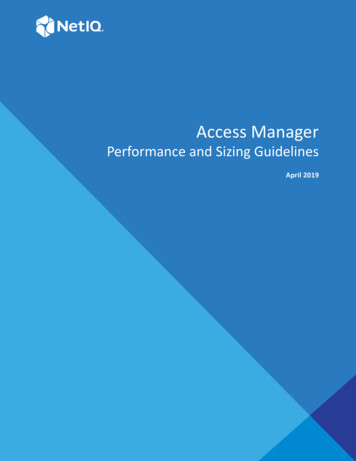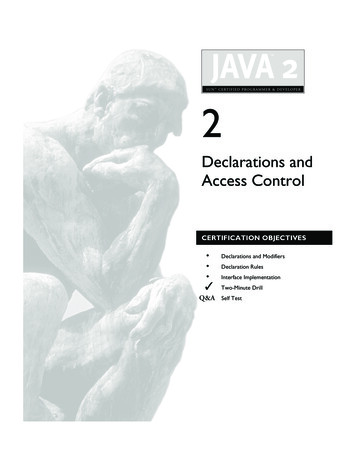
Transcription
Color profile: Generic CMYK printer profileCertPrs8(SUN) / Sun CertifiedComposite Default screenProgrammer & Developer for Java 2 Study Guide / Sierra / 222684-6 / Chapter 2Blind Folio 2:592Declarations andAccess ControlCERTIFICATION OBJECTIVES Declarations and ModifiersDeclaration RulesInterface ImplementationTwo-Minute DrillQ&A Self TestP:\010Comp\CertPrs8\684-6\ch02.vpFriday, November 15, 2002 11:20:28 AM
Color profile: Generic CMYK printer profile/ Sun CertifiedComposite Default CertPrs8(SUN)screen60Chapter 2:Programmer & Developer for Java 2 Study Guide / Sierra / 222684-6 / Chapter 2Declarations and Access ControlWe’re on a roll. We’ve covered the fundamentals of keywords, primitives, arrays,and variables. Now it’s time to drill deeper into rules for declaring classes,methods, and variables. We’ll tackle access modifiers, abstract methodimplementation, interface implementation, and what you can and can’t return from a method.Chapter 2 includes the topics asked most often on the exam, so you really need a solid graspof this chapter’s content. Grab your caffeine and let’s get started.CERTIFICATION OBJECTIVEDeclarations and Modifiers (Exam Objective 1.2)Declare classes, nested classes, methods, instance variables, static variables, and automatic(method local) variables making appropriate use of all permitted modifiers (such aspublic, final, static, abstract, and so forth). State the significance ofeach of these modifiers both singly and in combination, and state the effect of packagerelationships on declared items qualified by these modifiers.When you write code in Java, you’re writing classes. Within those classes, asyou know, are variables and methods (plus a few other things). How you declareyour classes, methods, and variables dramatically affects your code’s behavior. Forexample, a public method can be accessed from code running anywhere in yourapplication. Mark that method private, though, and it vanishes from everyone’sradar (except the class in which it was declared). For this objective, we’ll study theways in which you can modify (or not) a class, method, or variable declaration.You’ll find that we cover modifiers in an extreme level of detail, and though weknow you’re already familiar with them, we’re starting from the very beginning.Most Java programmers think they know how all the modifiers work, but on closerstudy often find out that they don’t (at least not to the degree needed for the exam).Subtle distinctions are everywhere, so you need to be absolutely certain you’recompletely solid on everything in this objective before taking the exam.P:\010Comp\CertPrs8\684-6\ch02.vpFriday, November 15, 2002 11:20:28 AM
Color profile: Generic CMYK printer profileCertPrs8(SUN) / Sun CertifiedComposite Default screenProgrammer & Developer for Java 2 Study Guide / Sierra / 222684-6 / Chapter 2Declarations and Modifiers (Exam Objective 1.2)61Class Declarations and ModifiersWe’ll start this objective by looking at how to declare and modify a class. Althoughnested (often called inner) classes are on the exam, we’ll save nested class declarationsfor Chapter 8. You’re going to love that chapter. No, really. Seriously. Nokidding around.Before we dig into class declarations, let’s do a quick review of the rules: There can be only one public class per source code file. The name of the file must match the name of the public class. If the class is part of a package, the package statement must be the first linein the source code file. If there are import statements, they must go between the package statementand the class declaration. If there isn’t a package statement, then the importstatement(s) must be the first line(s) in the source code file. If there are nopackage or import statements, the class declaration must be the first line inthe source code file. (Comments don’t count; they can appear anywherein the source code file.) Import and package statements apply to all classes within a source code file.The following code is a bare-bones class declaration:class MyClass { }This code compiles just fine, but you can also add modifiers before the classdeclaration. Modifiers fall into two categories: Access modifiers: public, protected, private Nonaccess modifiers (including strictfp, final, and abstract)We’ll look at access modifiers first, so you’ll learn how to restrict or allow access toa class you create. Access control in Java is a little tricky because there are four accesscontrols (levels of access) but only three access modifiers. The fourth access controllevel (called default or package access) is what you get when you don’t use any of theP:\010Comp\CertPrs8\684-6\ch02.vpFriday, November 15, 2002 11:20:28 AM
Color profile: Generic CMYK printer profile/ Sun CertifiedComposite Default CertPrs8(SUN)screen62Chapter 2:Programmer & Developer for Java 2 Study Guide / Sierra / 222684-6 / Chapter 2Declarations and Access Controlthree access modifiers. In other words, every class, method, and instance variable youdeclare has an access control, whether you explicitly type one or not. Although allfour access controls (which means all three modifiers) work for most method andvariable declarations, a class can be declared with only public or default access; theother two access control levels don’t make sense for a class, as you’ll see.Java is a package-centric language; the developers assumed that for goodorganization and name scoping, you would put all your classes into packages.They were right, and you should. Imagine this nightmare: three differentprogrammers, in the same company but working on different parts of aproject, write a class named Utilities. If those three Utilities classes have notbeen declared in any explicit package, and are in the classpath, you won’thave any way to tell the compiler or JVM which of the three you’re trying toreference. Sun recommends that developers use reverse domain names,appended with division and/or project names. For example, if your domainname is geeksanonymous.com, and you’re working on the client code for theTwelvePointOSteps program, you would name your package something likecom.geeksanonymous.steps.client. That would essentially change the nameof your class to com.geeksanonymous.steps.client.Utilities. Youmight still have name collisions within your company, if you don’t come upwith your own naming schemes, but you’re guaranteed not to collide withclasses developed outside your company (assuming they follow Sun’s namingconvention, and if they don’t, well, Really Bad Things could happen).Class AccessWhat does it mean to access a class? When we say code from one class (class A)has access to another class (class B), it means class A can do one of three things: Create an instance of class B Extend class B (in other words, become a subclass of class B) Access certain methods and variables within class B, depending on the accesscontrol of those methods and variables.In effect, access means visibility. If class A can’t see class B, the access level of themethods and variables within class B won’t matter; class A won’t have any way toaccess those methods and variables.P:\010Comp\CertPrs8\684-6\ch02.vpFriday, November 15, 2002 11:20:29 AM
Color profile: Generic CMYK printer profileCertPrs8(SUN) / Sun CertifiedComposite Default screenProgrammer & Developer for Java 2 Study Guide / Sierra / 222684-6 / Chapter 2Declarations and Modifiers (Exam Objective 1.2)63Default Access A class with default access has no modifier preceding it in thedeclaration. In other words, it’s the access control you get when you don’t type amodifier in the class declaration. Think of default access as package-level access,because a class with default access can be seen only by classes within the same package.For example, if class A and class B are in different packages, and class A has defaultaccess, class B won’t be able to create an instance of class A, or even declare avariable or return type of class A. In fact, class B has to pretend that class A doesn’teven exist, or the compiler will complain. Look at the following source file:package cert;class Beverage {}Now look at the second source file:package exam.stuff;import cert.Beverage;class Tea extends Beverage {}As you can see, the superclass (Beverage) is in a different package from thesubclass (Tea). The import statement at the top of the Tea file is trying (fingerscrossed) to import the Beverage class. The Beverage file compiles fine, but watchwhat happens when we try to compile the Tea file: javac Tea.javaTea.java:1: Can't access class cert.Beverage. Class orinterface must be public, in same package, or an accessible memberclass.import cert.Beverage;.Tea won’t compile because its superclass, Beverage, has default access and is ina different package. You can do one of two things to make this work. You couldput both classes in the same package, or declare Beverage as public, as the nextsection describes.P:\010Comp\CertPrs8\684-6\ch02.vpFriday, November 15, 2002 11:20:29 AM
Color profile: Generic CMYK printer profile/ Sun CertifiedComposite Default CertPrs8(SUN)screen64Chapter 2:Programmer & Developer for Java 2 Study Guide / Sierra / 222684-6 / Chapter 2Declarations and Access ControlWhen you see a question with complex logic, be sure to look at the accessmodifiers first. That way, if you spot an access violation (for example, a classin package A trying to access a default class in package B), you’ll know thecode won’t compile so you don’t have to bother working through the logic.It’s not as if, you know, you don’t have anything better to do with your timewhile taking the exam. Just choose the “Compilation fails” answer and zoomon to the next question.Public Access A class declaration with the public keyword gives all classesfrom all packages access to the public class. In other words, all classes in the JavaUniverse (JU) (you’ll be tested on this acronym) have access to a public class. Don’tforget, though, that if a public class you’re trying to use is in a different packagefrom the class you’re writing, you’ll still need to import the public class. (Justkidding about the JU acronym. We just made that up to keep you on your toes.)In the example from the preceding section, we may not want to place the subclassin the same package as the superclass. To make the code work, we need to add thekeyword public in front of the superclass (Beverage) declaration, as follows:package cert;public class Beverage {}This changes the Beverage class so it will be visible to all classes in all packages.The class can now be instantiated from all other classes, and any class is now free tosubclass (extend from) it—unless, that is, the class is also marked with the nonaccessmodifier final. Read on.Other (Nonaccess) Class ModifiersYou can modify a class declaration using the keyword final, abstract,or strictfp. These modifiers are in addition to whatever access control is onthe class, so you could, for example, declare a class as both public and final.But you can’t always mix nonabstract modifiers. You’re free to use strictfp incombination with abstract or final, but you must never, ever, ever mark aclass as both final and abstract. You’ll see why in the next two sections.You won’t need to know how strictfp works, so we’re focusing only onmodifying a class as final or abstract. For the exam, you need to know onlythat strictfp is a keyword and can be used to modify a class or a method, butnever a variable. Marking a class as strictfp means that any method code in theP:\010Comp\CertPrs8\684-6\ch02.vpFriday, November 15, 2002 11:20:29 AM
Color profile: Generic CMYK printer profileCertPrs8(SUN) / Sun CertifiedComposite Default screenProgrammer & Developer for Java 2 Study Guide / Sierra / 222684-6 / Chapter 2Declarations and Modifiers (Exam Objective 1.2)65class will conform to the IEEE754 standard rules for floating points. Without thatmodifier, floating points used in the methods might behave in a platform-dependentway. If you don’t declare a class as strictfp, you can still get strictfpbehavior on a method-by-method basis, by declaring a method as strictfp. Ifyou don’t know the IEEE754 standard, now’s not the time to learn it. You have, aswe say, bigger fish to fry.Final Classes When used in a class declaration, the final keyword meansthe class can’t be subclassed. In other words, no other class can ever extend (inheritfrom) a final class, and any attempts to do so will give you a compiler error.So why would you ever mark a class final? After all, doesn’t that violate thewhole OO notion of inheritance? You should make a final class only if you need anabsolute guarantee that none of the methods in that class will ever be overridden. Ifyou’re deeply dependent on the implementations of certain methods, then usingfinal gives you the security that nobody can change the implementation outfrom under you.You’ll notice many classes in the Java core libraries are final. For example, theString class cannot be subclassed. Imagine the havoc if you couldn’t guarantee howa String object would work on any given system your application is running on! Ifprogrammers were free to extend the String class (and thus substitute their newString subclass instances where java.lang.String instances are expected),civilization—as we know it—could collapse. So use final for safety, but only whenyou’re certain that your final class has indeed said all that ever needs to be said in itsmethods. Marking a class final means, in essence, your class can’t ever be improvedupon, or even specialized, by another programmer.Another benefit of having nonfinal classes is this scenario: imagine you find aproblem with a method in a class you’re using, but you don’t have the source code.So you can’t modify the source to improve the method, but you can extend the classand override the method in your new subclass, and substitute the subclass everywherethe original superclass is expected. If the class is final, though, then you’re stuck.Let’s modify our Beverage example by placing the keyword final in the declaration:package cert;public final class Beverage{public void importantMethod() {}}P:\010Comp\CertPrs8\684-6\ch02.vpFriday, November 15, 2002 11:20:29 AM
Color profile: Generic CMYK printer profile/ Sun CertifiedComposite Default CertPrs8(SUN)screen66Chapter 2:Programmer & Developer for Java 2 Study Guide / Sierra / 222684-6 / Chapter 2Declarations and Access ControlNow, if we try to compile the Tea subclass:package exam.stuff;import cert.Beverage;class Tea extends Beverage {}We get the following error: javac Tea.javaTea.java:3: Can't subclass final classes: classcert.Beverage class Tea extends Beverage{1 errorIn practice, you’ll almost never make a final class. A final class obliteratesa key benefit of OO—extensibility. So unless you have a serious safety orsecurity issue, assume that some day another programmer will need to extendyour class. If you don’t, the next programmer forced to maintain your codewill hunt you down and insert really scary thing .Abstract Classes An abstract class can never be instantiated. Its sole purpose,mission in life, raison d’être, is to be extended (subclassed). Why make a class if youcan’t make objects out of it? Because the class might be just too, well, abstract. Forexample, imagine you have a class Car that has generic methods common to allvehicles. But you don’t want anyone actually creating a generic, abstract Car object.How would they initialize its state? What color would it be? How many seats?Horsepower? All-wheel drive? Or more importantly, how would it behave? In otherwords, how would the methods be implemented?No, you need programmers to instantiate actual car types such as SubaruOutback,BMWBoxster, and the like, and we’ll bet the Boxster owner will tell you his cardoes things the Subaru can do “only in its dreams!” Take a look at the followingabstract class:abstract class Car {private double price;private Color carColor;private String model;private String year;public abstract void goFast();public abstract void , November 15, 2002 11:20:29 AM
Color profile: Generic CMYK printer profileCertPrs8(SUN) / Sun CertifiedComposite Default screenProgrammer & Developer for Java 2 Study Guide / Sierra / 222684-6 / Chapter 2Declarations and Modifiers (Exam Objective 1.2)67public abstract void impressNeighbors();// Additional, important, and serious code goes here}The preceding code will compile fine. However, if you try to instantiate a Car inanother body of code, you’ll get a compiler error:AnotherClass.java:7: class Car is an abstractclass. It can't be instantiated.Car x new Car();1 errorNotice that the methods marked abstract end in a semicolon rather thancurly braces.Look for questions with a method declaration that ends with a semicolon,rather than curly braces. If the method is in a class—as opposed to aninterface—then both the method and the class must be marked abstract.You might get a question that asks how you could fix a code sample thatincludes a method ending in a semicolon, but without an abstract modifieron the class or method. In that case, you could either mark the method andclass abstract, or remove the abstract modifier from the method. Oh,and if you change a method from abstract to nonabstract, don’t forget to changethe semicolon at the end of the method declaration into a curly brace pair!We’ll look at abstract methods in more detail later in this objective, but alwaysremember that if even a single method is abstract, the whole class must be declaredabstract. One abstract method spoils the whole bunch. You can, however, putnonabstract methods in an abstract class. For example, you might have methodswith implementations that shouldn’t change from car type to car type, such asgetColor() or setPrice(). By putting nonabstract methods in an abstractclass, you give all concrete subclasses (concrete just means not abstract) inheritedmethod implementations. The good news there is that concrete subclasses get toinherit functionality, and need to implement only the methods that definesubclass-specific behavior.(By the way, if you think we misused raison d’être, for gosh sakes don’t send anemail. We’re rather pleased with ourselves, and let’s see you work it into a programmercertification book.)P:\010Comp\CertPrs8\684-6\ch02.vpFriday, November 15, 2002 11:20:29 AM
Color profile: Generic CMYK printer profile/ Sun CertifiedComposite Default CertPrs8(SUN)screen68Chapter 2:Programmer & Developer for Java 2 Study Guide / Sierra / 222684-6 / Chapter 2Declarations and Access ControlCoding with abstract class types (including interfaces, discussed later inthis chapter) let’s you take advantage of polymorphism, and gives you thegreatest degree of flexibility and extensibility. You’ll learn more aboutpolymorphism in Chapter 5.You can’t mark a class as both abstract and final. They have nearly oppositemeanings. An abstract class must be subclassed, whereas a final class must notbe subclassed. If you see this combination of abstract and final modifiers,used for a class or method declaration, the code will not compile.EXERCISE 2-1Creating an Abstract Superclass and Concrete SubclassThe following exercise will test your knowledge of public, default, final, and abstractclasses. Create an abstract superclass named Fruit and a concrete subclass namedApple. The superclass should belong to a package called food and the subclass canbelong to the default package (meaning it isn’t put into a package explicitly). Makethe superclass public and give the subclass default access.1. Create the superclass as follows:package food;public abstract class Fruit{ /* any code you want */}2. Create the subclass in a separate file as follows:import food.Fruit;class Apple extends Fruit{ /* any code you want */}3. Create a directory called food off the directory in your class path setting.4. Attempt to compile the two files. If you want to use the Apple class, makesure you place the Fruit.class file in the food subdirectory.Method and Variable Declarations and ModifiersWe’ve looked at what it means to use a modifier in a class declaration, and now we’lllook at what it means to modify a method or variable y, November 15, 2002 11:20:29 AM
Color profile: Generic CMYK printer profileCertPrs8(SUN) / Sun CertifiedComposite Default screenProgrammer & Developer for Java 2 Study Guide / Sierra / 222684-6 / Chapter 2Declarations and Modifiers (Exam Objective 1.2)69Methods and instance (nonlocal) variables are collectively known as members. Youcan modify a member with both access and nonaccess modifiers, and you have moremodifiers to choose from (and combine) than when you’re declaring a class.Member AccessBecause method and variable members are usually given access control in exactlythe same way, we’ll cover both in this section.Whereas a class can use just two of the four access control levels (default orpublic), members can use all four: public protected default privateDefault protection is what you get when you don’t type an access modifier in themember declaration. The default and protected access control types have almostidentical behavior, except for one difference that will be mentioned later.It’s crucial that you know access control inside and out for the exam. Therewill be quite a few questions with access control playing a role. Somequestions test several concepts of access control at the same time, so notknowing one small part of access control could blow an entire question.What does it mean for code in one class to have access to a member of anotherclass? For now, ignore any differences between methods and variables. If class A hasaccess to a member of class B, it means that class B’s member is visible to class A.When a class does not have access to another member, the compiler will slap youfor trying to access something that you’re not even supposed to know exists!You need to understand two different access issues: Whether method code in one class can access a member of another class Whether a subclass can inherit a member of its superclassThe first type of access is when a method in one class tries to access a method ora variable of another class, using the dot operator (.) to invoke a method or retrieve avariable. For example,P:\010Comp\CertPrs8\684-6\ch02.vpFriday, November 15, 2002 11:20:29 AM
Color profile: Generic CMYK printer profile/ Sun CertifiedComposite Default CertPrs8(SUN)screen70Chapter 2:Programmer & Developer for Java 2 Study Guide / Sierra / 222684-6 / Chapter 2Declarations and Access Controlclass Zoo {public String coolMethod() {return "Wow baby";}}class Moo {public void useAZoo() {Zoo z new Zoo();// If the preceding line compiles Moo has access// to the Zoo class// But does it have access to the coolMethod()?System.out.println("A Zoo says, " z.coolMethod());// The preceding line works because Moo can access the// public method}}The second type of access revolves around which, if any, members of a superclass asubclass can access through inheritance. We’re not looking at whether the subclasscan, say, invoke a method on an instance of the superclass (which would just be anexample of the first type of access). Instead, we’re looking at whether the subclassinherits a member of its superclass. Remember, if a subclass inherits a member, it’sexactly as if the subclass actually declared the member itself. In other words, if asubclass inherits a member, the subclass has the member.class Zoo {public String coolMethod() {return "Wow baby";}}class Moo extends Zoo {public void useMyCoolMethod() {// Does an instance of Moo inherit the coolMethod()?System.out.println("Moo says, " this.coolMethod());// The preceding line works because Moo can inherit the public method// Can an instance of Moo invoke coolMethod() on an instance of Zoo?Zoo z new Zoo();System.out.println("Zoo says, " z.coolMethod());// coolMethod() is public, so Moo can invoke it on a Zoo reference}}P:\010Comp\CertPrs8\684-6 (reprint)\ch02.vpTuesday, February 25, 2003 6:00:40 PM
Color profile: Generic CMYK printer profileCertPrs8(SUN) / Sun CertifiedComposite Default screenProgrammer & Developer for Java 2 Study Guide / Sierra / 222684-6 / Chapter 2Declarations and Modifiers (Exam Objective 1.2)71Figure 2-1 compares the effect of access modifiers on whether a class can inherit amember of another class, or access a member of another class using a reference of aninstance of that class.Much of access control (both types) centers on whether the two classes involvedare in the same or different packages. Don’t forget, though, if class A itself can’t beaccessed by class B, then no members within class A can be accessed by class B.FIGURE 2-1Comparison ofinheritance vs.dot operator formember accessP:\010Comp\CertPrs8\684-6\ch02.vpFriday, November 15, 2002 11:20:30 AM
Color profile: Generic CMYK printer profile/ Sun CertifiedComposite Default CertPrs8(SUN)screen72Chapter 2:Programmer & Developer for Java 2 Study Guide / Sierra / 222684-6 / Chapter 2Declarations and Access ControlYou need to know the effect of different combinations of class and memberaccess (such as a default class with a public variable). To figure this out, firstlook at the access level of the class. If the class itself will not be visible toanother class, then none of the members will be either, even if the memberis declared public. Once you’ve confirmed that the class is visible, then itmakes sense to look at access levels on individual members.Public Members When a method or variable member is declared public,it means all other classes, regardless of the package they belong to, can access themember (assuming the class itself is visible). Look at the following source file:package book;import cert.*; // Import all classes in the cert packageclass Goo {public static void main(String [] args) {Sludge o new Sludge();o.testIt();}}Now look at the second file:package cert;public class Sludge {public void testIt() {System.out.println("sludge");}}As you can see, Goo and Sludge are in different packages. However, Goo caninvoke the method in Sludge without problems because both the Sludge class andits testIt() method are marked public.For a subclass, if a member of its superclass is declared public, the subclassinherits that member regardless of whether both classes are in the same package. Readthe following code:package cert;public class Roo {public String doRooThings() {// imagine the fun code that goes here}}P:\010Comp\CertPrs8\684-6\ch02.vpFriday, November 15, 2002 11:20:30 AM
Color profile: Generic CMYK printer profileCertPrs8(SUN) / Sun CertifiedComposite Default screenProgrammer & Developer for Java 2 Study Guide / Sierra / 222684-6 / Chapter 2Declarations and Modifiers (Exam Objective 1.2)73The Roo class declares the doRooThings() member as public. So if wemake a subclass of Roo, any code in that Roo subclass can call its own inheriteddoRooThings() method.package notcert; //Not the package Roo is inimport cert.Roo;class Cloo extends Roo {public void testCloo() {System.out.println(doRooThings());}}Notice in the preceding code that the doRooThings() method is invokedwithout having to preface it with a reference. Remember, if you see a method invoked(or a variable accessed) without the dot operator (.), it means the method or variablebelongs to the class where you see that code. It also means that the method orvariable is implicitly being accessed using the this reference. So in the precedingcode, the call to doRooThings() in the Cloo class could also have been writtenas this.doRooThings(). The reference this always refers to the currentlyexecuting object—in other words, the object running the code where you see thethis reference. Because the this reference is implicit, you don’t need to prefaceyour member access code with it, but it won’t hurt. Some programmers include itto make the code easier to read for new (or non) java programmers.Besides being able to invoke the doRooThings() method on itself, code fromsome other class can call doRooThings() on a Cloo instance, as in the following:class Toon {public static void main (String [] args) {Cloo c new Cloo();System.out.println(c.doRooThings()); //No problem; method is public}}Private Members Members marked private can’t be accessed by code inany class other than the class in which the private member was declared. Let’s makea small change to the Roo class from an earlier example.package cert;public class Roo {private String doRooThings() {// imagine the fun code that goes here, but only the Roo class knows}}P:\010Comp\CertPrs8\684-6\ch02.vpFriday, November 15, 2002 11:20:30 AM
Color profile: Generic CMYK printer profile/ Sun CertifiedComposite Default CertPrs8(SUN)screen74Chapter 2:Programmer & Developer for Java 2 Study Guide / Sierra / 222684-6 / Chapter 2Declarations and Access ControlThe doRooThings() method is now private, so no other class can use it. If wetry to invoke the method from any other class, we’ll run into trouble.package notcert;import cert.Roo;class UseARoo {public void testIt() {Roo r new Roo(); //So far so good; class Roo is still publicSystem.out.println(r.doRooThings()); //Compiler error!}}If we try to compile the UseARoo class, we get the following compiler error:%javac Balloon.javaBalloon.java:6: No method matching doRooThings() found in classcert.Roo.r.doRooThings();1 errorIt’s as if the method doRooThings() doesn’t exist, and as far as any codeoutside of the Roo class is concerned, it’s true. A private member is invisible to anycode outside the member’s own class.What about a subclass that tries to inherit a private member of its superclass?When a member is declared private, a subclass can’t inherit it. For the exam, youneed to recognize that a subclass can’t see, use, or even think about the privatemembers of its superclass.
CertPrs8(SUN) / Sun Certified Programmer & Developer for Java 2 Study Guide / Sierra / 222684-6 / Chapter 2 Class Declarations and Modifiers We’ll start this objective by looking at how to declare and modify a class. Although nested (often called inner) classes are on the

